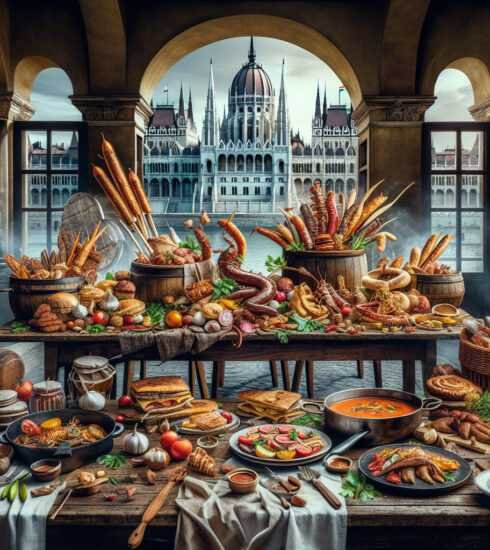Embark on an Exquisite Culinary Expedition in Budapest: Unveiling the Rich Heritage of Hungarian Cuisine
Delve into the Rich Heritage of Hungarian Cuisine: Embarking on an Exquisite Culinary Expedition in Budapest
If you’re a food enthusiast with a taste for adventure, a culinary trip to Hungary is an absolute must. Hungarian cuisine is renowned for its rich flavors, hearty dishes, and unique combinations of ingredients. The country’s capital, Budapest, is the perfect starting point for a gastronomic journey that will tantalize your taste buds and immerse you in the rich heritage of Hungarian food. From traditional dishes like goulash and chimney cake to contemporary creations in Budapest’s vibrant food scene, there’s something for every palate to savor. Join us as we explore the delicious world of Hungarian cuisine on an unforgettable culinary expedition.
Uncovering the History and Influences of Hungarian Cuisine
Hungarian cuisine is a reflection of the country’s rich history and diverse cultural influences. Over the centuries, Hungary has been influenced by various ethnic groups, including the Magyars, Turks, Austrians, and Slavs. These influences have shaped the flavors and ingredients that are synonymous with Hungarian food today.
One of the most significant influences on Hungarian cuisine is the Ottoman Empire. During the Turkish occupation in the 16th and 17th centuries, the Ottomans introduced spices and cooking techniques that are still prevalent today. This influence can be seen in dishes like paprika-spiced stews and savory pastries.
Another important influence on Hungarian cuisine is the Austro-Hungarian Empire. The Austrians brought with them their love for rich, hearty dishes, such as schnitzel and strudel. These dishes have become an integral part of Hungarian culinary tradition.
Magyars, the original inhabitants of Hungary, also shaped the country’s gastronomy with their own unique culinary practices. They introduced dishes like goulash, which has since become a celebrated Hungarian classic. Goulash is a flavorful stew made with tender chunks of meat, paprika, and vegetables, usually served with dumplings or noodles.
With such a rich heritage, Hungarian cuisine offers a delightful tapestry of flavors, with each dish telling a story of the country’s history and cultural influences.
The Essential Ingredients of Hungarian Cuisine
To truly understand Hungarian cuisine, you must delve into the key ingredients that define its flavors. These ingredients play a crucial role in the distinctiveness of Hungarian dishes and are a testament to the country’s agricultural traditions.
1. Paprika
Paprika is without a doubt the most essential ingredient of Hungarian cuisine. It is ubiquitous in Hungarian dishes and adds a vibrant red color and mild spiciness to the food. Hungarian paprika comes in different varieties, ranging from sweet to hot, and each has its own unique flavor profile. Whether it’s sprinkled on goulash, stuffed in sausages, or used as a seasoning in savory dishes, paprika is the soul of Hungarian cuisine.
2. Sour Cream
Sour cream, or tejföl in Hungarian, is another fundamental ingredient in Hungarian cooking. It brings a tangy richness and creamy texture to many traditional dishes. Sour cream is often used as a topping for soups, stews, and savory pastries, adding a delightful contrast to the flavors.
3. Garlic

Garlic is a staple in Hungarian cuisine, adding a pungent and aromatic flavor to many dishes. It is used as a seasoning in stews, roasted meats, and sausages, infusing them with its distinctive taste. Garlic is also commonly used in pickling vegetables, which are often served as a refreshing side dish with heavier Hungarian meals.
4. Caraway Seeds
Caraway seeds are a common ingredient in Hungarian cuisine, lending their distinct flavor to many dishes. They are often used in sauerkraut, soups, and bread, adding a mild earthy taste and a hint of sweetness.
5. Hungarian Sausages
Hungarian sausages, or kolbász, are a beloved part of Hungarian cuisine. These sausages are made from a variety of meats, including pork, beef, and game, and are seasoned with spices like paprika, garlic, and pepper. Hungarian sausages are usually smoked or cured, giving them a robust flavor that pairs well with other traditional dishes.
Traditional Hungarian Dishes: A Gastronomic Delight
A visit to Budapest is incomplete without indulging in the traditional Hungarian dishes that have stood the test of time. Here are some of the must-try dishes that will take your taste buds on a delightful journey through Hungarian culinary traditions.
1. Goulash
No exploration of Hungarian cuisine is complete without a bowl of authentic Hungarian goulash. This hearty stew is made with tender beef, paprika, onions, and an assortment of vegetables. The flavors are further enhanced with the addition of caraway seeds, garlic, and bay leaves. Goulash is traditionally served with nokedli, small dumplings that soak up the rich sauce.
2. Chicken Paprikash
Chicken paprikash, or csirkepaprikás, is another iconic Hungarian dish. It features tender chicken simmered in a rich paprika-infused sauce, usually thickened with sour cream. The dish is traditionally served with nokedli or Hungarian dumplings and garnished with fresh parsley.
3. Hortobágyi Pancake
Hortobágyi pancake, or hortobágyi húsos palacsinta, is a savory pancake filled with a flavorful meat mixture. The meat is typically seasoned with paprika, onions, and garlic, and then wrapped in a pancake before being baked with a creamy sauce. It’s a delicious and filling dish that showcases the versatility of Hungarian cuisine.
4. Lángos
Lángos is a popular street food in Hungary and a favorite among locals and tourists alike. It is a deep-fried dough that is typically topped with sour cream and grated cheese. Lángos can be enjoyed plain or with additional toppings like garlic butter, bacon, or sausages. It’s a simple yet satisfying treat that is perfect for a quick snack or a late-night indulgence.

5. Dobos Torte
Dobos torte is a traditional Hungarian cake that is as visually stunning as it is delicious. It consists of multiple layers of sponge cake filled with rich chocolate buttercream and topped with a caramel glaze. The cake is often decorated with intricate patterns, making it a true work of art. Dobos torte is a must-try for anyone with a sweet tooth.
Contemporary Hungarian Cuisine: Exploring Budapest’s Food Scene
While traditional Hungarian dishes hold a special place in Hungarian culinary heritage, Budapest’s food scene has also seen a surge of contemporary and fusion cuisine in recent years. The city’s vibrant culinary landscape offers a wide array of options for those seeking innovative and modern interpretations of Hungarian flavors.
Budapest has embraced the concept of “ruin bars,” which are trendy bars and restaurants set up in abandoned buildings and courtyards. These eclectic spaces blend the charm of Budapest’s architectural heritage with a vibrant atmosphere and a diverse range of food and drinks. Ruin bars have become a hallmark of Budapest’s nightlife scene and are a great place to experience the fusion of traditional and contemporary Hungarian cuisine.
Exquisite dishes in Budapest’s food scene often incorporate traditional flavors and cooking techniques with a modern twist. Chefs are experimenting with unique combinations of ingredients and presentation styles, creating stunning dishes that push the boundaries of Hungarian cuisine.
Food festivals and street food markets are also popular in Budapest, where you can sample a variety of Hungarian and international cuisines in a lively and bustling atmosphere. These events offer a fantastic opportunity to taste a wide range of flavors and interact with local chefs and food enthusiasts.
Budapest’s Culinary Tours: Embark on an Unforgettable Food Adventure
If you want to make the most of your Hungarian culinary expedition, consider joining a guided food tour in Budapest. These tours offer a curated selection of the city’s top food spots, allowing you to indulge in a variety of dishes while learning about their history and significance.
One highly recommended tour is the Hungarian Flavors tour by Hungary Trip. This tour takes you on a journey through Budapest’s gastronomic hotspots, where you can savor traditional Hungarian dishes and explore the city’s vibrant food scene. The tour includes visits to local markets, traditional ‘kifőzde’ eateries, and contemporary restaurants, providing a well-rounded experience of Hungarian cuisine.
Another popular tour option is the Budapest Ruin Bars tour, also by Hungary Trip. This tour takes you through the city’s unique ruin bars, where you can sample Hungarian street food, local beers, and innovative cocktails. You’ll get a taste of Budapest’s nightlife while experiencing the fusion of traditional and contemporary flavors.
Whether you choose a culinary tour or explore the city’s food scene on your own, Budapest offers a gastronomic adventure like no other. From traditional dishes steeped in history to contemporary creations that push the boundaries of Hungarian cuisine, there’s something to satisfy every food lover’s cravings.
Conclusion
A culinary expedition in Budapest is a feast for the senses, immersing you in the rich flavors and cultural heritage of Hungarian cuisine. From traditional dishes like goulash and chicken paprikash to contemporary creations in Budapest’s vibrant food scene, each bite tells a story of Hungary’s history and influences. Whether you sample local specialties at traditional eateries or explore the city’s eclectic food markets, Budapest offers a gastronomic adventure that will leave you craving for more. Embark on your own culinary journey and discover the hidden treasures of Hungarian cuisine.
Image source: Unsplash.com






